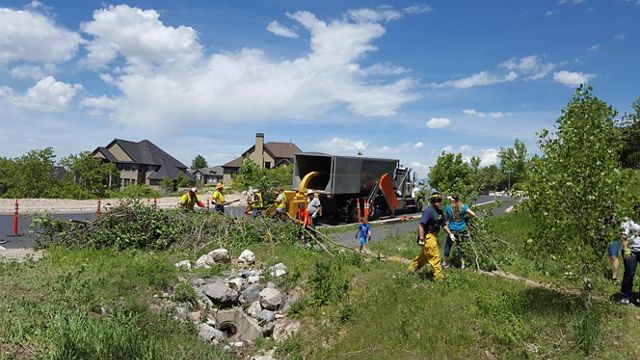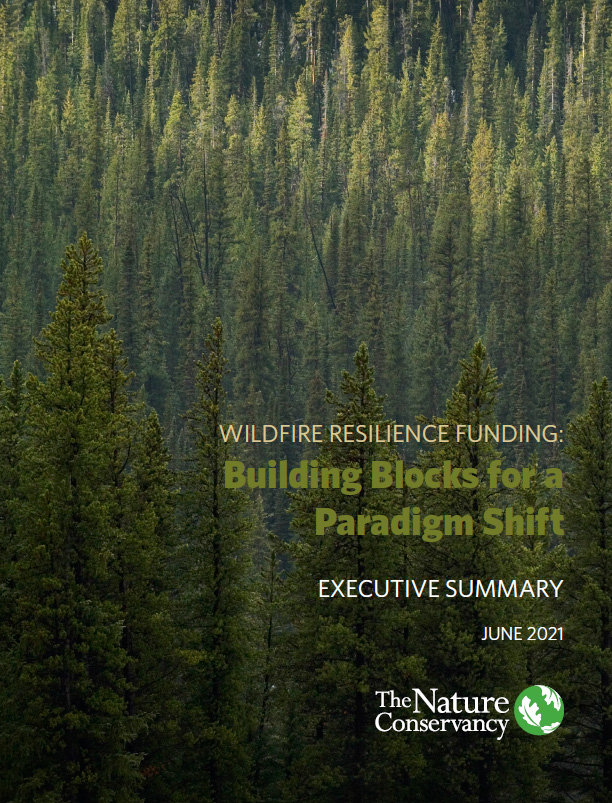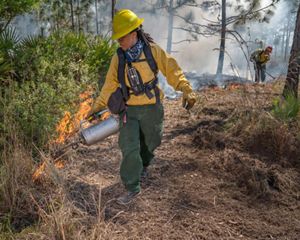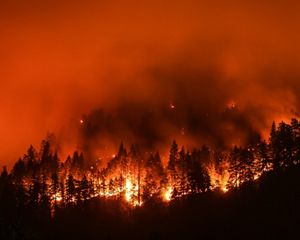
Funding for Wildfire Resilience: Strategies for a Paradigm Shift
It is time for bold, transformative policy action to reduce risks of catastrophic wildfires.
TNC's Wildfire Resilience Funding Report
The risks and costs of wildfires are increasing, causing loss of life, property, and ever greater harm to communities and the environment. The 2018 wildfire season in California alone caused $150 billion in direct and indirect economic losses—and the 2020 fire season was worse. We know these trends will continue to worsen: the West is getting warmer and drier and is facing historic drought conditions. More people, communities and assets are being exposed to fire risk and are more vulnerable to harm. Meanwhile, fires are increasing in frequency and intensity.
Keys to a Paradigm Shift
- Substantial increase in investments in all federal programs
- A holistic, strategic approach across government to address scale of need, rather than an incremental and piecemeal approach.
- Manage wildfire resilience as a public good, highlighting co-benefits.
And yet wildfire resilience spending is not keeping pace with the increasing costs of wildfire suppression, or the far more substantial economic impacts associated with catastrophic wildfire events. In the last 10 years, federal suppression costs alone have grown by nearly 400%, while wildfire resilience investments have remained essentially flat. This approach is not working, leaving us further and further behind a growing problem.
It is time for a paradigm shift: bold, transformative policy action to reduce risks of these catastrophic wildfires. We must change the future trajectory for how we manage and prepare for wildfire impacts in our country and our communities.
Addressing this challenge over the next 10 years requires an investment surge of $5 billion to $6 billion per year for the highest priority work of reducing wildfire risks and providing communities with much-needed resources for infrastructure and adaptation.

Quote
In the last ten years, federal suppression costs alone have grown by nearly 400%, while wildfire resilience investments have remained essentially flat.
Three Pathways to a Surge in Investment
We took a comprehensive look across the federal government for pathways to increase spending on wildfire resilience, creating a menu of options for policymakers to build towards fully funding the cost of top priority work over the next 10 years.
- Increase investments in, and improve coordination of, existing federal programs where wildfire resilience is either a core or complementary outcome.
- Broaden focus to bring in new agencies that focus on pre-disaster mitigation while developing a whole-of-government wildfire resilience strategy.
- Expand public-private partnerships, private investment and other innovative strategies to leverage government investment in resilience.
Existing Federal Programs
Many federal programs currently support wildfire risk reduction and resilience. Core programs include wildfire resilience as a principal program objective and generally focus on activities like hazardous fuels reduction, prescribed fire and mechanical treatments. Complementary programs prioritize other management outcomes (e.g., timber production, insect and disease management and watershed health), yet wildfire resilience is a co-benefit. Significant new investments in core programs would require changes in program management, such as new outcome-based performance metrics, the ability to commit to multi-year funding, landscape scale planning and improved processes for partners and private dollars to leverage federal investments and capacity. Targeted investments in complementary programs can help to further institutionalize wildfire resilience goals and help build the capacity, infrastructure and markets for wildfire resilience. Examples of such programs include: Collaborative Forest Landscape Restoration Program, Joint Chiefs Landscape Restoration Program, Hazardous Fuels, Joint Fire Science and USDA Job Corps.
Proposed Annual Funding Levels: $3.6 Billion

New and Emergent Federal Programs
A broad range of federal agencies and programs, outside of traditional land management agency budgets, can also support wildfire resilience through pre-disaster mitigation. Strong executive branch leadership is needed to better integrate these opportunities into a whole-of-government wildfire resilience strategy. The Wildland Fire Leadership Council (WFLC) can play a key role in syncing programs of work, funding opportunities and establishing performance criteria. There may also be a need to expand WFLC representation to include the Federal Emergency Management Agency (FEMA) and Department of Defense (DOD) to ensure emergency response agency leadership is complemented by those who lead pre-disaster mitigation work. These efforts must also be elevated within the federal government to allow for transformative change. The White House can support cross-federal evaluation and delivery of opportunities and benefits through coordinated budget strategy, policy development and stakeholder engagement. Examples of such programs include: Building Resilient Infrastructure and Communities Program, Readiness and Environmental Protection Initiative, Regional Conservation Partnership Program and Rural Development.

Next Steps
Government leaders and partners must employ a more strategic and coordinated approach to deploying federal programs to reduce wildfire risks and invest in wildfire resilience in ways that contribute to addressing climate change, advancing economic recovery, and supporting historically underserved and excluded communities. A surge in investment to address wildfire resilience will require new appropriations and legislation. The bipartisan infrastructure bill, which includes significant investments and provisions related to clean energy, community resilience, natural infrastructure, and forest health, is an excellent step in the right direction. Additional opportunities include:
- Infrastructure Legislative Packages
- President’s Budget & Annual Appropriations
- New Stimulus Funding
- 2023 Farm Bill
- Climate Change Legislative Packages
It's time to change the paradigm.

Wildfire Resilience Funding Report
-
 Wildfire Resilience Funding (Executive Summary)
Wildfire Resilience Funding (Executive Summary)Wildfire Resilience Funding: Building Blocks for a Paradigm Shift
Download


